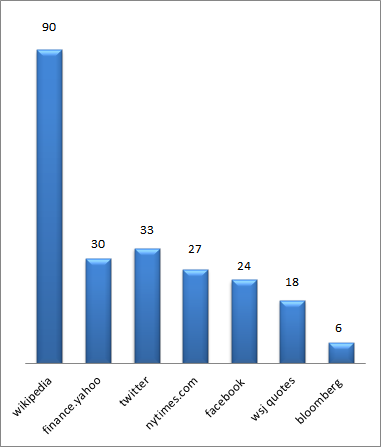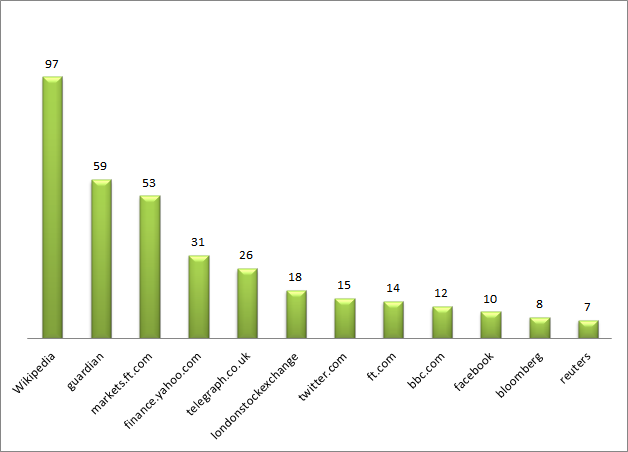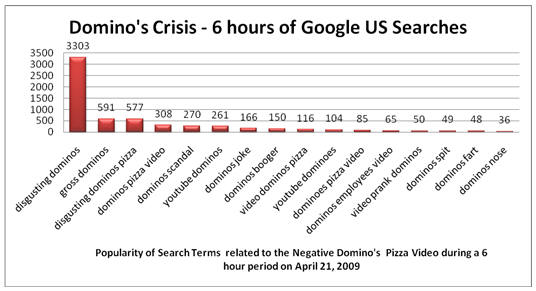It Pays to Be Wordy…And It’s Free!
Twitter jumped into the 2017 holiday season with something new for its 330 million users: the gift of more gab. As of early November, it officially doubled the character limit for a tweet, jumping from 140 to 280 characters.
Reactions so far are split on whether this is a good thing, with some already mourning the loss of creativity forced by the 140-character constraint. However, there is a major hidden benefit to Twitter’s new world of wordy: the way it affects your search results page.
Since August 2015, when someone Googles a term associated with a Twitter account, the search results have included a dedicated space for actual tweets from that account. That’s a win for companies, brands, and people who care about their online presence. It means their voice is right there on the search results page, in a section whose contents they completely control.

With Twitter’s newly doubled character count, we wondered if Google would come along for the ride. Would the Twitter box on the search page double in size? Or would it just cut off the tweet after 140 characters?
The answer? For Twitter boxes featuring the wordier 280-character tweets, the actual box has grown to accommodate the greater length.

This is an incredible branding gift from Twitter and Google, offering even more space in the search results for a brand (or company, or individual) to control and to tell their own story. This is the kind of space brands pay money to have on the search page.
Brands should welcome this gift with open keyboards. They have learned how to be creative in 140 characters; now it’s time to embrace the new challenge to be engaging, yet still pithy, in 280.
What’s more, companies can reap the benefits of a longer Twitter box on the search page without being needlessly wordy all the time. The box works as a carousel, allowing the searcher to scroll horizontally through a few recent tweets, beyond just the first three showing. We discovered that if any of the tweets in the box – even the ones not initially visible – are longer, it lengthens the whole box.

In this new era of Twitter 280, brands have the opportunity to offer deeper thoughts, or even just thoughts that are longer winded. That’s their choice. But now it pays to be wordy – without even having to pay.
What’s The Social Footprint of 100 Most Influential Communicators?
The Holmes Report partnered with Five Blocks to analyze the social media footprint of the Influence 100.
By a large margin, LinkedIn is the most popular network for this group. Twitter shows solid usage as well. Facebook presence, on the other hand, is significantly lower. YouTube came in at last place.
Interestingly enough, 15% of the Influence 100 have no social media results of their own ranking on page 1 of Google.
What CMOs Need To Know About SEO
“Early in 2015 Twitter and Google struck a deal, and as a result you’re likely to see more tweets showing up in Google search results. Exactly how this will play out and how it will impact SEO remains to be seen.” Miriam Hirschman explores the possibilities in a post at Search Engine Land. “What isn’t in doubt is that being active on Twitter is more important than ever.”
What Signals From Twitter Does Google Care About?
Earlier this year, Google and Twitter struck a deal which once again gave Google access to Twitter’s data stream. Columnist Miriam Hirschman explores how this might play out.
Ever since news of the Google-Twitter deal broke in early February 2015, there has essentially been radio silence. We know that the deal gives the search giant access to Twitter’s “firehose” of live tweet data; but, thus far, there has been no information released on what search results will look like once the deal is implemented “in the first half of this year“ (which itself is already half over). Read More
Brand Reputation for the FTSE 100 vs. the Fortune 100
Before we can start work aligning a brand’s online reputation to match their corporate objectives, we need to understand something about the playing field.
We need to understand what types of results are typical for brands in the same market. Many of our clients are Fortune 100 and Fortune 500 companies, so we have done extensive research into this market.
Below is a table depicting the frequency with which we find various sites as top ten results in Google’s natural search results. (Data is from Nov 9, 2012).
The number above each bar represents the number of company search results in which each website appears.
As you can see from this chart, the most prevalent result for companies in the Fortune 100 is Wikipedia – appearing in 90% of page one results for Fortune 100 companies.
It’s interesting to note that Facebook and Twitter are each appearing in F100 first page Google results about 25% of the time.
Also interesting is that Yahoo Finance continues to be an important finance site as compared to Google Finance – which does not show up in the top ten.
A takeaway for companies in the space would be to look at the frequently occurring websites and determine if your brand should also have similar results. Knowing that Google tends to “like” showing a specific type of result seems to make it low-hanging fruit – an easy win if it’s something that will help your online reputation.
What about the FTSE 100?
In preparation for a week of meetings in London, we decided to compare the same type of data as seen in Google.co.uk results for the FTSE 100.
In the UK, Wikipedia is even more prevalent. Only 3 FTSE 100 companies have no Wikipedia page appearing in their Google page 1 results! Also noteworthy is the strength of The Guardian as a result shown in the first page Google results for 59% of all FTSE 100 companies! (Note to PR department – The Guardian is more likely to impact online reputation than the BBC, The Telegraph and Reuters combined!). In the UK Markets.ft.com outranks Yahoo Finance in prevalence by a significant margin, with Yahoo Finance still maintaining a significant foothold.
On the social media front, Twitter and Facebook are less than half as likely to be in the Google first page search results for a FTSE 100 company – as compared to a Fortune 100 company.
Notable as well is that neither group has video results coming up with any frequency. Image results show up in 6 of the FTSE 100 search results, but in only 2 of the Fortune 100 first page results.
With this knowledge, we are better prepared to look at FTSE 100 companies – and indeed at company results for other companies in the UK with a better understanding of which sites play significant roles in online reputation. When we approach a client program, we then take the additional step of doing a more exact comparison of the peer group – the companies or individuals that are most similar to the client. This offers further insight as to the way in which Google treats those keywords within the local search market.
‘Disgusting Dominos’ Tops Dominos Searches
One of the great things about Online Reputation Management is that it includes more than just creating some blogs or generating links. It’s a lot about the perception of searchers. How do they view your company? What frame of mind are they in? What can you do to change impressions? The variety of tactics we utilize in repairing online reputations is constantly evolving. Eighteen months ago we hardly touched Twitter; now it’s a staple. Google’s personalized profiles are also a new development – allowing any user to grab the profile page for their name (which shows up instantly just below the Google top ten with a picture).
In this fast-paced environment, we make sure to see and evaluate what happens a week or more after a crisis.
The Domino’s Test
On April 21, 2009 our company decided to run Google Ads in order to gauge the longer-term effects of negative publicity from Domino’s Pizza’s now infamous “disgusting video.” Our test took place more than a week after the release of the famous employees YouTube video.
Aside from over 25,000 impressions, coming primarily from ads appearing on YouTube, we measured over 3,000 searches for the broad term ‘disgusting dominos.’
Domino’s themselves evidently realized that this would be the ‘best’ keyword to capture the crisis and decided to make their YouTube response title: “Disgusting Dominos People – Domino’s Responds”. This was probably at the urging of their SEO expert. While the best way to rank a YouTube video for a keyword is to start the title of the video with your keyword, I would argue that the negative aspect of having the CEO’s picture under the title “Disgusting Dominos” is a reason to veer away from this tactic. Instead, I would have recommendeded “Dominos CEO responds to Disgusting Dominos People Video.” The actual video file should probably have been called “Disgusting Dominos” as we have seen empirically the effects of the file name itself outweighing the video title. Using the keyword as the title of the video file is very helpful in making sure the video shows up in YouTube for your keyword.
Disgusting Domino’s – the Top Keyword for the Domino’s Crisis in Reputation Management
We noted that throughout our test, Domino’s Pizza themselves did not seem to be running any Google Ads – possibly a missed opportunity to reassure searchers that Domino’s is aware of the issue and is proactively dealing with it.
Note: Domino’s is a trademark of Domino’s Pizza. This site is not related to Domino’s in any way.
Domino’s Pizza Retrospective: Why PR Must Own the “Google Top Ten” in Today’s Era of Online Reputation Management
This piece was written by David Goldman and originally appeared in the Daily Dog on April 27, 2009.

PR firms are responsible for their client or company’s reputations. Similar to the Domino’s fiasco, if a negative video or blog reaches into the top ten of Google search results for a client’s brand name, it’s called a “PR problem.” So why aren’t PR firms called on more often to fix the problem with their client’s online reputation?
One answer is that most people assume that Google search results are like the weather. We have the tools to measure them and possibly predict them, but we can’t change them. Fortunately, the situation isn’t that bad. Experienced online reputation management (ORM) firms working in tandem with PR firms can control a client’s search profile. The best way to get rid of negative results on Google is to take control of your reputation online. Another answer is that online reputation management should belong to the client’s SEO firm. This is a missed opportunity for PR and oftentimes untrue.
Progressive agencies are taking ORM seriously, partnering with firms or making internal hires to accommodate the growing need for bridging their traditional and even online efforts to ORM services. They realize that PR firms are competing with SEO companies to provide these services and understand the strategic as well as the financial sense in getting there first. Agencies should understand that they are often creating the message and image of the brand while SEO firms are technology people.
The Domino’s Case Study—Timely ORM Tips to Consider
Just over a week after the Domino’s “PR Nightmare,” many communications professionals are asking two questions: What can the brand do to salvage its reputation after the fact? And what can we do to prevent our clients from a similar crisis? Here is how our firm would work with Domino’s PR to clean up the mess:
There are at least three things that Domino’s Pizza should be doing now to clean up their online reputation. Although the buzz around the infamous video will continue to wane, the postings and marketing articles about the incident have the potential to linger for months, possibly years, unless the brand takes action. If you’re Domino’s, here’s what you need to do today:
1. Tweet to a stronger presence online. A company that is such an important part of American culture should be actively creating positive buzz online. Domino’s didn’t even have a Twitter account until after the crisis broke.
Pizza Hut recently posted a job offer for a summer intern to work on their Twitter account (see the posting here: http://news.cnet.com/8301-17852_3-10223100-71.html). That’s the type of planning that helps soften a social media crisis when it arises. With 125,000 employees at their disposal, Domino’s could easily distribute an internal memo advocating that employees open Twitter accounts and post positive comments about the work environment and the company. Twitter is one of the fastest ways to have a positive impact on a brand. Domino’s employees have a real interest in making their brand popular and keeping it strong. This will not only help supplant the negative content from the top search results in time, but help prevent a future crisis as well.
2. Develop and execute a video strategy. Currently, most of the videos that appear on YouTube and video-sharing websites for the keyword “dominos” are not about Domino’s Pizza. Had Domino’s occupied the top ten spots on YouTube for the keyword “dominos,” the effects of a rogue negative video would have been greatly mitigated. There was a lost opportunity as the millions of searchers for the keyword “dominos” could have also been exposed to positive messages from the brand in the form of videos.
In addition, the brand’s TV commercials should be systematically re-posted and optimized so they occupy the top spots for video searches of the word “dominos.” Management should also ask employees to create YouTube videos promoting the brand, empowering the employees to feel like they are part of the solution, not only the problem.
3. Go “deep”—leverage mini-sites. Domino’s probably thought that by having a consumer-focused website and a corporate homepage they had their bases covered. In truth, their web presence is shallow.
Creating mini-sites on a few important topics can garner excellent PR while protecting the brand’s online reputation. Some topics Domino’s could consider for mini-sites: a) Passion for Pizza (The Internet is the perfect medium for expressing the passion you have for your product or service.), b) Domino’s and the Environment (focusing on recycling or other green initiatives), and c) Domino’s Scholarships (or Domino’s Community Projects). Each of these mini-sites can occupy a top spot in the Google results if created and optimized by ORM experts.
The Bigger Picture—Why PR Must Own ORM
All of these suggestions are facets of a full-service online reputation management program. When ideas like these are implemented together with a program of reputation management focused on positive articles and links, a negative situation can be transformed into a reputation-building opportunity.
Although Online Reputation Management (ORM) has existed for several years, today the need for this service is more relevant than ever. It isn’t a question of whether companies need and seek this type of service anymore. The real question is: To whom will they turn?
We have met with many PR firms in the U.S. who offer a “blogging strategy,” creating and maintaining an optimized corporate blog for their clients. While this is an excellent first step, online reputation management requires much more than one well-run blog. These firms often subscribe to outside services in order to track their client’s reputation online, but rarely do they offer a solid measurable solution.
So what is the better model?
Answer: Stop offering blogs and start offering “search profile optimization.” A search profile is essentially what someone sees when they search for your client’s brand or product name; it’s the “Holy Grail of Search;” it’s the Google top ten. Today, there are several ORM firms with whom agencies and consultants can partner—offering a white-label solution to their clients to improve their search profiles. The ORM firm provides charts and graphs that track the progress of their work for the PR firm to merchandise back to the client with their ‘look and feel.’
There are methods (especially for clients who are vulnerable to the “Domino’s Effect”) that can greatly reduce the collateral damage of a scandal before it takes place. By “owning” the Google top ten before a crisis breaks out, PR firms can effectively prevent a catastrophe. On a brand’s marketing team, only the PR firm knows when the bad news is coming. Whether it’s layoffs, a poor earnings report or a discrimination lawsuit, this knowledge can be used to minimize damage to the brand by securing the Google top ten in advance of the negative announcement.
Providing ORM services for clients is a way for PR firms and crisis communications professionals to stay vital to their clients and gives clients another reason to stick with their agencies. In this uncertain economy, every PR professional should be finding new ways to increase revenues and retain their clients. Offering ORM services allows PR firms to do both.



